

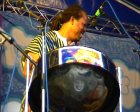
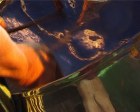
STEEL PAN - THE HISTORY
Out of Slavery
Born out of repression the steel pan has an extraordinary history closely linked to the carnival celebration of granting freedom to the island's slaves. These carnivals were seen by the authorities as anti-establishment. While not able to ban them, they outlawed firstly the African skin drum.
Tamboo Bamboo
The Tamboo Bamboo bands developed to replace skin drums as 'road march' music and a focus to the carnival by beating differing lengths of bamboo with a stick were also banned.
Bottles, biscuit tins and saucepans were sought out as replacement instruments. A Trinidadian named Spree Simon, found, by banging a dustbin lid with a hammer, he could alter pitch and that different sized indentations resulted in differing notes. The metal of the dustbin lids was too thin.
From Humble Oil Drum
In the 1930's it was realised that oil drums were made of the ideal metal for hammering into the musical instrument that was to become the steel pan. These were taken up and made into steel drums in pan yards in the roughest most deprived shanty towns in Port of Spain. And so the only recognised acoustic instrument to be developed in the 20th century was born.
The Steel Pan Explodes
Lethal steel pan clashes took place between bands. Once again it became illegal to play this 'noisy instrument' and pan players were arrested for disturbing the peace.
Despite the repression (or because of it) steel pan yards mushroomed all over Trinidad by 1945 and the government was unable to ban the pan. They tried a different approach of taming and controlling it through assimilation.
Heading to London Town
In the 1950's some of the best pan players of the time were selected to represent Trinidad as part of the Commonwealth. The TASPO steel pan came to England for the Festival of Britain, some members stayed on in England in the Portobello area of Notting Hill, the area becoming a hub for steel pan in the UK. The steel pan became the heartbeat of the largest street festival in Europe - the Notting Hill Carnival.
Panorama and the Big Backers
Gauging its great popularity in Trinidad and Tobago, the authorities encouraged corporate sponsorship. Like football sponsors, firms got huge publicity with bands like the Shell Invaders, ICI All Stars, Nestle's Ambassadors and Timex Merry Makers, especially in the annual finals of the national steel pan competition - Panorama. Steel pan bands had begun to become respectable and by the end of the 1970's there were over 300 bands in Trinidad and Tobago.
From Road March to Debussy
Having the resonance of a drum and the range of notes of a piano the steel pan proved itself an extraordinary versatile instrument both subtle and powerful in application - capable of beating out the fiercest rhythms of a road march or playing Debussy.
Corporate sponsorship was required to fund the international tours of these large bands. In the 1960's, Fimber Bravo played lead pan in Pan Am North Stars, regarded then as the greatest steel band in the world, they had been on the Ed Sullivan Show and toured the globe playing complicated and sophisticated orchestrations of classical symphonies from Carnegie Hall in New York to the London Palladium.
From Debussy to Grand Master Flash
In 1972, when Pan Am North Stars came to England, the band broke up. A group of its members, including Fimber Bravo as lead pan, formed the Twentieth Century Steel Band. They wanted a sound from the pan that was contemporary and innovative and not dominated by corporate sponsorship.
Influenced by Black Power, they did not want to play Euro Centric classics or the colonially acceptable 'rum and coke' cruise boat sounds. They wanted the pan to have its own cutting edge music to excite young audiences. Signed by United Artists, they produced the seminal steel pan album Warm Heart, Cold Steel, that gave birth to the rap classic anthem Heaven and Hell sampled by over 30 black super stars, from Grand Master Flash to Jennifer Lopez.
Going Solo
The steel pan is usually thought of as a massed sound - 120 band members thundering it out at Carnival time back in Port of Spain or here in the UK in the Grove. But take it down to one, to the solo, and it can be as sweet and gentle as any other instrument.
Once again Fimber Bravo is breaking new ground with the steel pan. Along with other steel pan greats like Len (Boogsie) Sharp, Rudi (Tooleft) Smith and Robbie Greenidge, he has developed it as a solo instrument and become recognised internationally as a solo steel pan player.
Fimber Bravo has in a way brought the steel pan back to its roots, to his predecessors on the road march who used the outlawed African drum of their ancestors. In the Eighties as musical director of Steel'n Skin he started to combine steel pan with the traditional skin drums of Africa.
With his CD's Beat and Small Talk he has created a groundbreaking fusion of the steel pan with the Kora and a range of other African instruments, like the Jembe and Koloko described below.
How a Pan is Made
The Steel pan, like so many other instruments is based on the principle of varying vibration. Hammering down the top of the pan (originally the top of a 45 gallon scrap oil drum) is called sinking the pan. This is usually done with a sledge hammer and requires accuracy to obtain the right tone. The position of the notes is then marked out using a steel punch and a hammer. This is called grooving. Individual sections are then raised up around the sunken dip. This enables the frequency of the vibrations to change to provide a range of notes within the pattern. The pan is then burnt to improve the tone on tuning and is cooled off with cold water.
Tuning a pan is a highly skilled job and carried out with a small hammer and master key to make adjustments to blend tone and the right sound on the notes. Pan players have their favourite tuners for their instrument.
The pan is then played with short lengths of sticks tipped with red inner tube rubber from bicycle tyres to dampen any harsh dissonant sounds.
top of page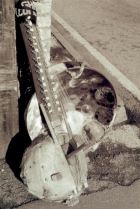
THE KORA
How is it Made
Its harp like sound flows from a half gourd covered with leather stretched over it and left to dry to form the dome or sounding box of the instrument. This then supports a long neck on which is suspended 21 nylon strings secured by an end pin and carried over the gourd on a high bridge. Before nylon or fishing line was available braided strips of antelope hide were used but the sound was more muted than that of the modern kora.
The strings of various lengths are tuned by adjusting the leather thongs by which they are attached to the neck.
A Proud Tradition
The Kora has been the doyen instrument of the Mandinka Kingdom of West Africa since the 13th Century. While in appearance resembling a harp, the notched bridge of the kora has lead many to suggest that the kora was the forerunner of the steel guitar.
Certainly musicians like Taj Majal and Toumani Diabete have established the link between the rhythms and resonances of the Blues emerging from slavery and the ancient music of the kora playing Jelis or Griots from Mandinka society.
Among the names that are notably associated with the Jelis are the surnames Kouyate and Diabete.
The Kora is played in West Africa in Mali, Burkina Faso, Sierra Leone and Senegal with Gambia having the most kora players. The Kora is one of Africa's most sophisticated instruments - widely heard in world music fusions in addition to modern and traditional African presentations.
top of page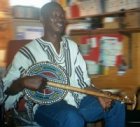
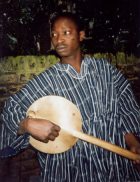
THE KOLOKO (Ngoni)
How is it Made?
A two stringed lute, the Koloko is made from a calabash gourd and from goat skin. The strings are made of fishing line and like its relative the Kora the Koloko's strings used to be made of animal gut or strips of dried hide. African ancestor to the American Banjo, the koloko comes originally from Mali.
Where is it Played?
It is played in Mali, Nigeria and Burkino Faso, as well as in Northern Ghana. It is called a Koloko in Frafra, a Molo in Hausa and in Bambara, Ngoni. It is also found in Morocco and in Gambia, Mali and Guinea, a 5 or more string version is played by the Mandinka.
Traditional and Modern
On Small Talk the Koloko is played by Atongo Zimba, a world class exponent of the instrument from Northern Ghana. African ancestor to the American Banjo, it comes originally from Mali. Atongo's grandfather and others players would use the instrument to entertain and motivate farm workers and for ritual occasions such as funerals. The instrument was also played in the pito (local beer) bars.
Atongo makes his own acoustic instruments. For larger performances he uses an electrified version. He is believed to be amongst the first to use the instrument for more general entertainment purposes. His style of playing is unique: whilst it is often traditionally strummed as a rhythmic accompaniment to the voice, Atongo picks the strings to gain a melodic effect.
top of page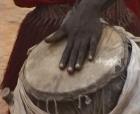
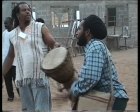
THE JEMBE
How is it made?
A single piece of wood is used (in Ghana, Mango trunk) and hollowed out. Other countries, like Nigeria use heavier hard wood. A dried goat or antelope skin is stretched across the hollowed wood and strung with strips of hide around the base, which are used to tighten the drum and tune for use. Said to originally been made by the Numu of the Mandinka, Jembe have traditionally been heavily carved on the body of the drum with significant symbols.
One of Africa's Oldest Drums.
The Jembe (Djembe in France) is the Senegalese term for the drum that is one of the oldest and most common drums in West Africa. In Sierra Leone - the drum is called The Samgbai and in Liberia The Tuquie.
How is the Jembe played?
Variations in styles of playing between jembe drummers from Ghana, Mali, Senegal, Sierra Leone, Burkina Faso and Guinea can be noted by experts, but broadly speaking the technique of drumming applied is the same everywhere and is based on the use of the strokes of slap, tone and bass in differing rhythms.
Jembe rhythms are linked to ritual dances performed in villages to a set purpose or ritual, at specific times of the year or for special occasions and often in a special place. They could be performed for warriors, for celebrations or to encourage good harvests.
A village drumming event can be performed over many hours. Drummers and dancers speak to one another through movement focusing on one or only a few dance central rhythms. There will be, however, times that the drummers respond or provoke the dances with searing fast tempos as can be seen in the video with Henri Gaubi and Emmanuel Tagoe.
National Ballets and Master Drummers
Both Henri and Emmanuel have come to international recognition as Master Drummers by playing for the prestigious National Ballets, formed to reflect the finest of drumming and dance traditions within Cote D'Ivoire and Ghana. This has become an established route for the cream of virtuoso Jembe players within West Africa.
Gradually as Jembe playing has gain ascendancy within Europe and North America groups of players have moved their drumming away from its traditional communal role within the village community and performed without dancers and solely for entertainment.
Diluting the Drum Language?
Some purists argue that this separation represents a dislocation from the very essence of true Jembe drumming. They believe the drum language will be diluted without playing to impart significant meaning to dancers and to the village community.
The Jembe has gained wide spread popularity in the West and groups of players can be found on street corners and at every major pop festival. There is no doubt that their playing sometimes bears little relation to the Jembe played as a vital voice communicating established messages to dancers in say a Mandinka village ritual. The playing does, however, celebrate communal participation and enables African Jembe players to maintain their art as respected teachers and musicians.
A Dynamic Evolution
Some contemporary practitioners like the singer songwriter Vinx electronically mike and amplify the instrument giving it in performance another dimension.
Music has always had a vital energy precisely because it evolves fuses and transforms drawing on new influences to develop the traditional and traditional influences to impact and change contemporary composition. In the 21st Century there is an unprecedented interest worldwide in the Jembe that is taking it in many new directions.
top of page